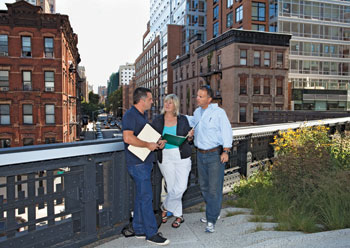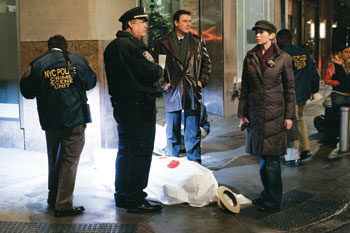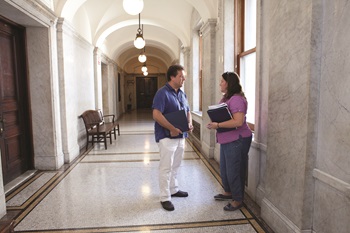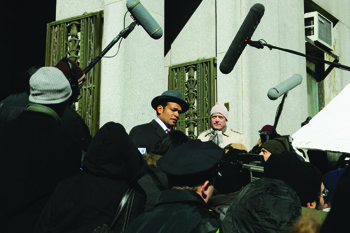BY ANN FARMER
Photographed by Kristine Larsen
 TOP OF THE WORLD: Law & Order: Special Victims Unit UPM Gail
TOP OF THE WORLD: Law & Order: Special Victims Unit UPM Gail Barringer (left) and Trish Adlesic survey the scene from the roof of a
Times Square building where the show managed to shoot four locations.
On a muggy August evening, Trish Adlesic, the location manager for Law & Order: Special Victims Unit, and Gail Barringer, the show's unit production manager, stand on the roof deck of a 61-story apartment building in Times Square. On the floor below in the penthouse, the cast and crew are shooting a scene for a fall episode about a drunk real estate developer who commits a vicious murder. With its floor-to-ceiling windows overlooking lower Manhattan and ultra modern furniture, the apartment is serving as the luxury home of the victim's best friend.
Hours earlier, the production had wrapped a scene on the 31st floor, a space that was supposed to be a building developer's office in a different neighborhood, as suggested by its views of cranes and construction sites. The series also shot a street scene under the building's glass and steel entry on 42nd Street. And before the day is over, they will move to a conventionally decorated penthouse on the opposite side of the building. When the episode finally airs, viewers will have no reason to suspect that all four settings were shot in the same building.
"It's rare that we can find so many sets in one location," says Barringer, who had been there since early morning monitoring the production. "It's great because we don't have to move the trucks. We just have to move up and down the elevator."
Finding New York locations, securing them and making sure they are used as efficiently as possible is a major task for the unit production managers and location managers (who are covered as 2nd ADs in the New York area under the latest DGA contract) of the Law & Order franchise, which includes the original Law & Order series and its spinoffs: Law & Order: Criminal Intent and Law & Order: Special Victims Unit. "We all love going out and shooting on location," says Mary Rae Thewlis, one of two unit production managers on Criminal Intent. The location manager comes up with the sites and the unit production manager approves and oversees their use. With the original series marking its 20th anniversary next year and its spinoffs each approximately 10 years old, that's thousands of locations every year.
As Adlesic and Barringer stand on the rooftop looking across all of Manhattan and parts of New Jersey, they point to neighborhoods, parks and edifices they've used. "We've shot in Central Park, the Museum of Natural History, Chinatown, Little Italy, the Trump building, Harlem," says Adlesic. Glancing over the railing at a fairly nondescript gray and black building stationed at the mouth of the Lincoln Tunnel, she adds, "that's one we use all the time," explaining that it's an office building easily accessible from the show's studio in New Jersey.
 AROUND TOWN: (top) Location manager Tom Ross, UPM Mary Rae Thewlis
AROUND TOWN: (top) Location manager Tom Ross, UPM Mary Rae Thewlis and UPM Michael Smith check out a location for Law & Order: Criminal Intent.
 Chris Noth (center) and Julianne Nicholson star in the show.
Chris Noth (center) and Julianne Nicholson star in the show.
(Photo: Will Hart/NBC Universal)
"The location manager has an enormous creative impact on the look of the show," says John Coles, one of the executive producers and directors of Criminal Intent. Each show shoots approximately 50 percent of its scenes at locations in and around New York. (The other scenes are shot on sets.) If an episode is particularly location heavy, it might require as many as 40 spots. "If the location manager doesn't understand the vision or appetite of the director," Coles adds, "it puts them at a disadvantage."
Adlesic, for instance, tenaciously pursued the United Nations building for an episode last season about child soldiers who emigrate from Africa, even though the UN had never allowed a television production to shoot inside its hallowed grounds before. Another episode on illegal smuggling made it necessary to film (and temporarily house) some rare, exotic animals. "It's difficult when you say, 'I want to bring in tigers and hyenas and lemurs,'" says Adlesic, describing how she approached the owner of a warehouse and he responded by saying, "Are you crazy?"
When Bridget Clark, the location manager of Law & Order, was asked to find a place to shoot an episode about a towering construction crane toppling over, she found a real construction site on a dead-end street in Spanish Harlem, thus saving enormous crane rental fees.
And when Criminal Intent's location manager, Tom Ross, was told to locate a house jutting out of a marshy beach that looked like Nantucket, what he found on Long Island was so believable that the L.A. editor on the show guessed it was shot upstate. "Tom Ross has a creative brain that makes it work," says UPM (and occasional director) Michael Smith. Smith says often in initial script reading meetings, "I'll see Tom's wheels turning. He'll whisper to me, 'I have the perfect location.'"
Since locations are such a big chunk of the below-the-line expenses, UPMs spend a great deal of prep time on where the show is shooting. After the location manager has narrowed down the options, the UPM piles into a vehicle with the director, AD and others to take a look. Once the director okays the site, the location manager negotiates the contracts and the UPM approves the amount and oversees the location's use.
To reduce the time and expense of moving the cast and crew from one location to another, the UPMs and the location managers on the three shows like to create hubs out of several locations in the same vicinity. That usually involves one hard-to-find location grouped with several easier, more generic locations. "Oh my gosh, there's a scene in a roller rink," says Thewlis, giving an example. "That's going to be hard. Let's make that a hub and work around it."
Ross is especially proud of a Staten Island hub he put together for Criminal Intent. "We shoot a lot on Staten Island because we get a lot of suburban looks out there in addition to rural and urban looks," he says, describing how he found, within a short distance of each other, locations that passed for a bed and breakfast in Massachusetts, a prison in upstate New York, a farmhouse in the Pennsylvania Dutch countryside, and a condo in Arizona. For the last one, he says, "We found this development and put a cactus in front. We always find something."
And if that doesn't work they can always create something. Barringer, who started out as a production accountant, says Special Victims recently needed a cemetery. But there were no cemeteries near the Manhattan hubs they'd created. "I said, 'We have green grass in New Jersey. Why not make foam tombstones painted to look like real tombstones? They'll be littered on the front lawn of the studio,'" says Barringer, who saved the production $15,000 with that solution.
A viable location must satisfy a range of requirements: Is it true to script? How good is the parking and loading situation? If an apartment has high-end artwork, does it need to be removed for protection? "You can never check enough. You'll be amazed at what can come up," says Adlesic, describing, for instance, how she'll scope out the area for schools. Otherwise, "Suddenly at 3 p.m., a huge block of kids will be coming down the street."
While each show has thousands of locations on file, no show likes to return anywhere too often. Viewers might pick up on it. So the Law & Order location managers routinely send scouts on the prowl, who take pictures, knock on doors and place inquiries.
Clark recalls sending a new female assistant on a scouting expedition for a men's bathroom for a Special Victims episode. Locating a public bathroom, the scout knocked several times before entering. As she was taking pictures of the stalls, a homeless man fell out of one of them. "You get to see the true spectrum of living in New York," says Clark. "We joke that we do a lot of exteriors in the winter and a lot of interiors in the summer. Anytime we're supposed to find a dead body in water it's winter. They want hotels during holidays. They want schools in September."
The longstanding popularity of the original Law & Order series often comes in handy when trying to persuade a reluctant location owner to provide access. "People love the show," says Clark. On the other hand, working on Special Victims, which deals with sex crimes, can be a drawback. "People are sometimes leery to have their place depicted as the place where someone gets killed or raped," says Adlesic.
 THE ORIGINAL: Law & Order location manager Bridget Clark and
THE ORIGINAL: Law & Order location manager Bridget Clark and
UPM Moe Bardach in the halls of justice.
 Mario Van Peebles on the steps of the frequently used New York Supreme
Mario Van Peebles on the steps of the frequently used New York Supreme
Court building. (Photo: Virginia Sherwood/NBC Universal)
Jeffrey Hayes, who worked on the original series as a UPM and executive producer from its inception in 1990 to 2004, says the fact that the original writers weren't from New York sometimes created a problem. "They always wanted to find a body in an alley. There are like two alleys in New York," says Hayes, who would often have better suggestions. For instance, instead of filming a police awards ceremony in a ballroom that required lighting and 500 extras, he suggested doing it on the steps of City Hall with bag pipers and a few cops. "It looked great. And it didn't cost anything. We made a donation to the NYPD Emerald Society." He adds, "You have to be in the city to get that."
Once a location is settled on, the location manager and UPM return with various department heads on a technical scout to determine technical issues such as how much set dressing is required. "Sometimes we totally redecorate," says Ross, who assigns a location manager to the site during shooting to ensure that things run smoothly while he turns his attention to the next episode's locations.
Meanwhile, the UPMs continue to monitor the production on location and set days. On a hot afternoon in August, Moe Bardach, one of the UPMs of Law & Order, was outside the classic courtroom set that's used in every episode of the flagship show. As various crewmembers approached him with problems, he kept an eye on some television monitors transmitting the different takes. The UPMs on the original Law & Order are also producers and Bardach says directors often ask them for their opinion on takes.
The three shows pretty much stay out of each other's way. Criminal Intent and Law & Order house their sets at the Chelsea Piers studio while Special Victims works out of New Jersey. Sometimes the other shows might ask to borrow the flagship's courtroom or its Rikers Island holding pen set. There's only one place that all three shows amiably converge—at the New York Supreme Court building at 60 Centre Street in downtown Manhattan, where characters have been killed and the shows' district attorneys routinely hold press conferences. "We film there almost every episode, either on the steps or inside," says Bardach. While technically it's free to use the space, Law & Order makes regular donations. "With that money," says Bardach, "they've restored the rotunda ceiling. I feel proud of that."
The UPMs go out of their way to contain the show's footprint in a neighborhood. The Mayor's Office of Film, Theatre & Broadcasting maintains a hot spot list of neighborhoods where filming is temporarily prohibited because of complaints or overuse from all the film and television production in the city. The Law & Order crews work hard to get in and out of locations fast. "If you go into a bar or restaurant early and get out by lunch hour," says Hayes, "then they're happy to get us back."
One thing that has changed since 9/11 is the ability of the productions to talk their way into some places that were more open before the World Trade Center bombings. For instance, when shooting last season's finale of Criminal Intent the script called for a terrorist explosion of a downtown bank.
"The Mayor's Office stayed firm," says Smith. "No big explosions below 14th Street since 9/11." However, they got permission to create an aftermath scene in the Wall Street area that included smoke, a burned-out car and fire engines. But they ran into further resistance for a scene in which the detectives visit a container port in New Jersey where the chemicals used in the bomb were allegedly brought into the country. Homeland Security nixed that plan, saying it would interfere with articles being X-rayed, and prohibited them from using all the other obvious places, too.
Coles was directing that episode of Criminal Intent and says Ross refused to give up. On the third or fourth day of shooting, he found a boat repair yard that fit the bill. "Parameters unlock the imagination rather than contain it," says Coles, who doesn't believe anyone watching the show will ever guess it's not a container port. "Without sounding Pollyannaish," says Coles, "location managers like Tom Ross pull off something extraordinary on a weekly basis. And with the production manager, they pull off the show."